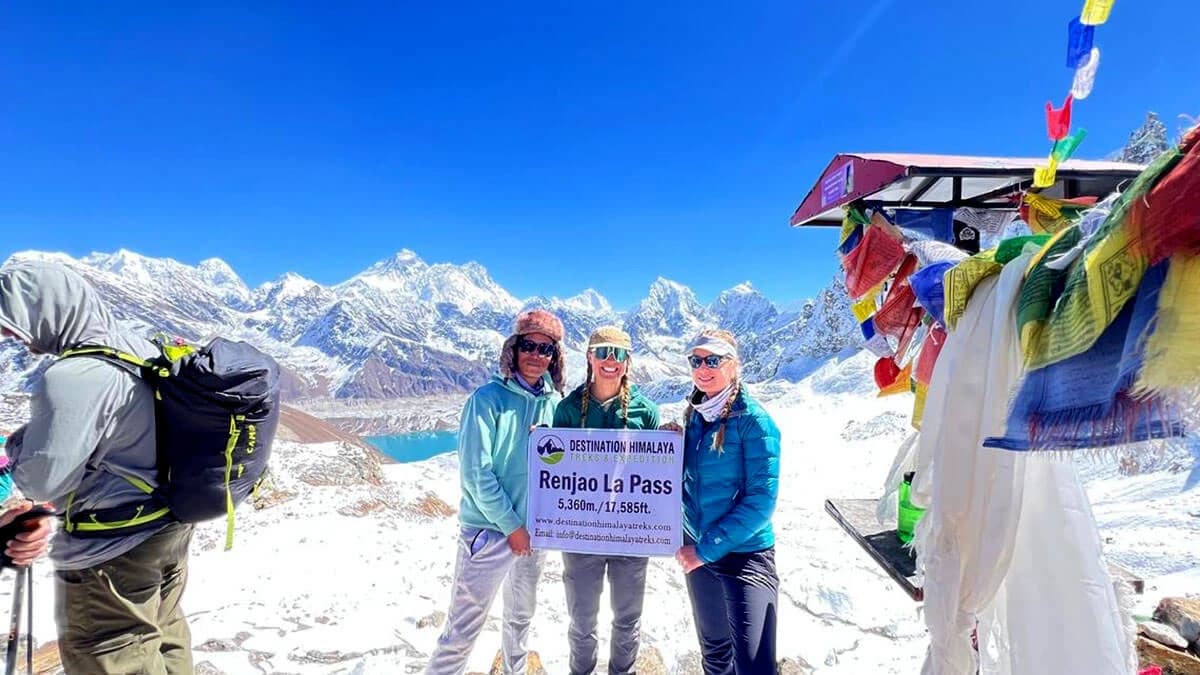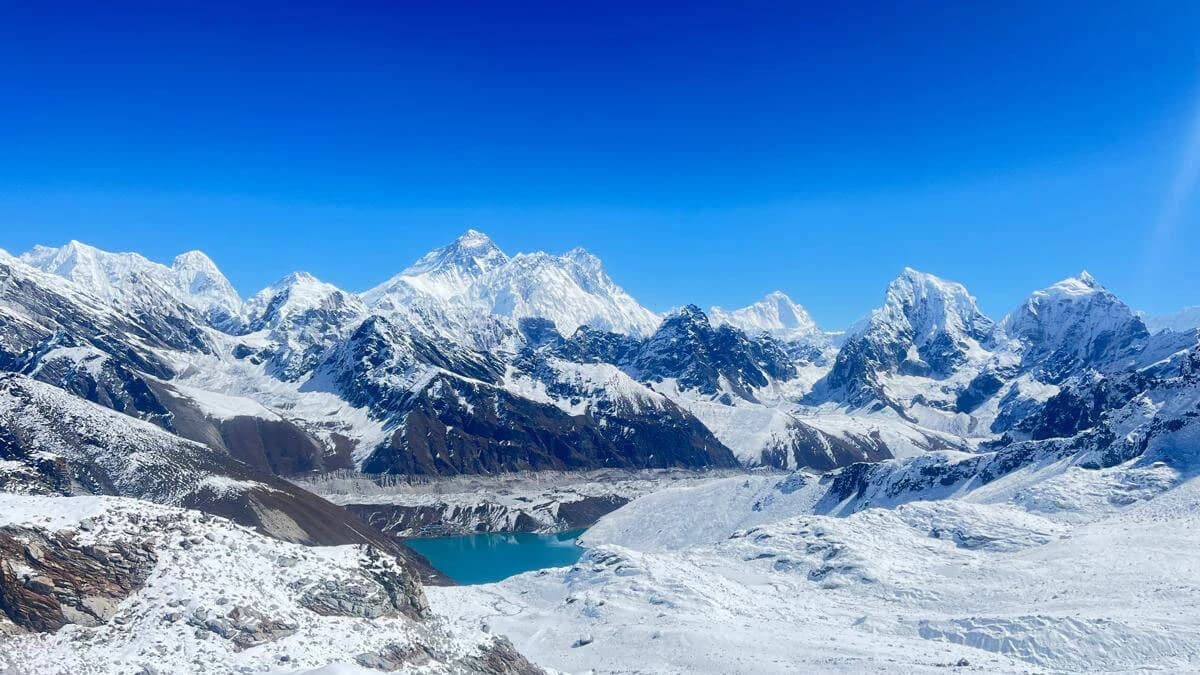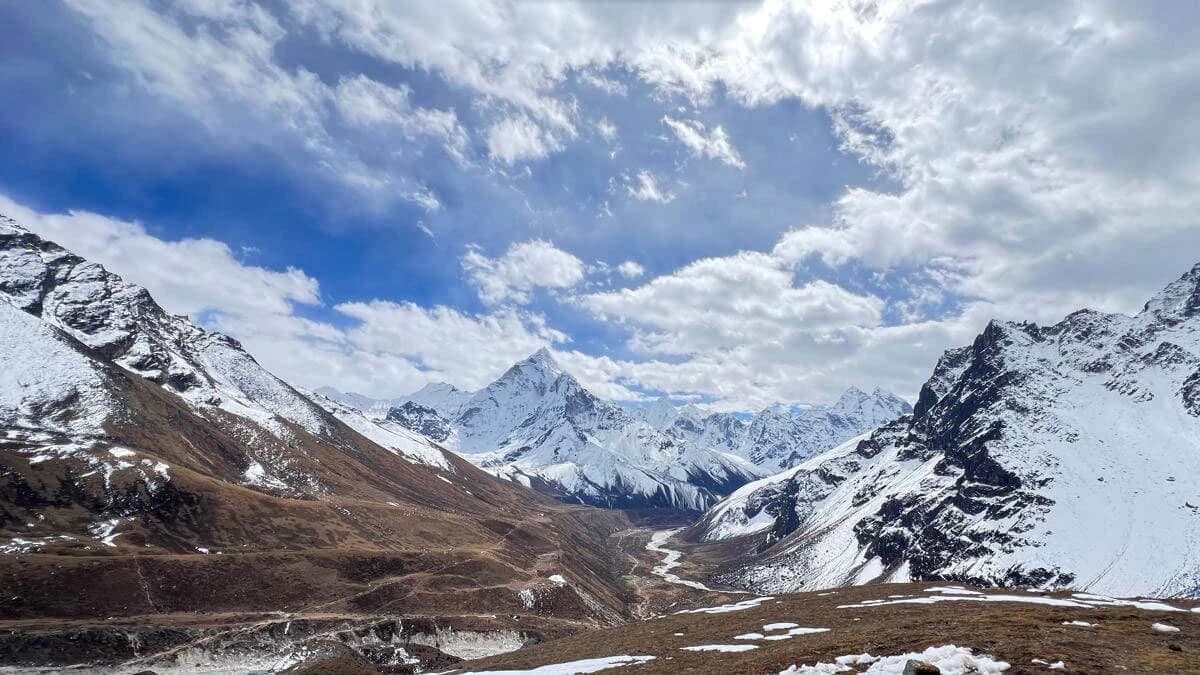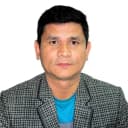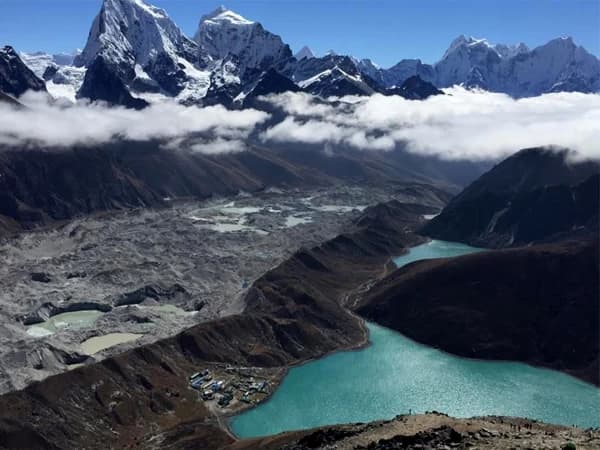Have you ever dreamt of surrounding yourself with the best views of the world's highest peak of Mount Everest, but grew up knowing that the EBC Trailhead is filled with thousands of people, which doesn't allow you to fully immerse yourself in nature. Well! You might be familiar with the Three High Passes, which tower at 5000 meters in height, but demand ample preparation and prior experience. What if we say that you do not even require prior experience, but enjoy the unparalleled view of Everest at the same time, and also gaze over the holy six lakes of Gokyo, and also let you cross over Renjo La Pass - one of the 3 high passes giving a sense of achievement.
YES! Such an adventurous journey exists; this is the Gokyo Lake Renjo La Pass Trek that lets you immerse yourself in the unique perspective of the Everest region through the untamed off-beaten trailhead, leaving the crowded route behind.
Detailed Overview
Gokyo Lake and Renjo La Pass Trek is a less-traveled route within the Khumbu region that ascends to the vantage point of Gokyo Ri and reaches the 5360 elevation of Renjo La - one of the passes of the legendary Everest Three Passes, showcasing a glacial valley, diverse landscapes, unhindered views of mountains along the emrald alike Gokyo Lake that sparkle brightly with the surrounding Himalayan Range.
It is a dream-come-true adventure for lone hikers who love to explore something unique, barren terrains, and the rich tapestry of Sherpa culture as it follows the ancient route, unlike the Everest Base Camp Trek. This 12-day Gokyo Renjo La Pass Trek stands out to be a top-notch destination that offers the unparalleled views of some of the iconic peaks in the world, where more than 10 mountains, including the Makalu, Cho Oyu, Pumori, Ama Dablam, Lhotshe, and even the climbing peak of Lobuche, befriend throughout the journey reminding us that every challenges en route comes with greatest reward.
This Gokyo Lake Renjo La Pass Trekking route meanders through the "Sagarmatha National Park" right from the beginning, after taking an astonishing flight to Lukla from Kathmandu, and the walking trail head begins soon after, towards Phakding along the glacier-fed Dudh Koshi River side by side. While navigating through the forested area, make sure to catch a glimpse of rare wildlife, as more than 12 elusive red pandas, Himalayan tahr, and more than 8 snow leopards at higher elevations were found in 2025 - a haven for wanderers.
Throughout the journey, this trek bypasses several sherpa villages, the ancient ones such as Luza, Machhmero, Dole, Tongma, Lungden, Lhabarma, Pangka, through Nilibuk Cave with an insight into the traditional lifestyle of sherpa communities with no influx of modernization, unlike the regular standard route, letting you get an in-depth knowledge about how traditional tea houses and trailheads were like in the 1980s era. En route, you'll also visit some of the ancient monasteries dotted with whitewashed mani walls, chortens, red shrines, and colorful Tibetan prayer flags influenced by Tibetan Buddhism.
One of the most highlighted sections of this Renjo La Pass Trek is the Gokyo Ri View Point (5357 m), which offers an astonishing view of the Gokyo Lake, which stretches to the Ngozumpa Glacier- the largest glacier amid the Himalayas. In between, it traverses through the other five holy lakes of Gokyo and the exploration of Gokyo valley, a perfect relishing time before ascending to the highest altitude.
The highest point is Renjo La Pass, which this expedition attains, showcasing the best 360 panorama vista of Makalu, Rolwaling Range, Tingri, and stretches to over Tibetan Range with the spectacular vista of Cho Oyu touching the Tibetan Border. Standing here, bypassing such rugged sections, will surely make you feel that every step that you've undertaken in this journey has become noteworthy.
All in all, this trek to Gokyo and Renjo La is an once in a life time adventure that fits all pace of hikers, whether you are a beginner, or have a limited time duration and don't want to have frustrating preparation to climb technical sections of other two high passes, then this adventure of 12 days is made for you! Now, it's your turn take whether to enlist this odyssey as your go to adventure for future, if so then wait no longer!
Please take a note that, this trek doesn't reach the base camp of Everest, however if you have a long duration holiday and want a bit more thrilling adventure 1 level up then, consider opting for EBC via Gokyo Lake that reaches the holy six lake and the foothill of the world's heighest peak at the same time.
Highlights of Gokyo Lake with Renjo La Pass
- Witness panoramic views of Everest, Lhotse, Makalu, and Cho Oyu from Gokyo Ri, total 4 highest mountains in the world
- Enjoy a thrilling flight to Lukla, looking over the giant mountains
- Cross the demanding Renjo La High Mountain Pass, which provides spectacular views of Everest and Ngozumpa Glacier, and Tibetan mountain peaks
- Hike next to the 36km Ngozumpa Glacier and observe its glacial formations along with its supraglacial lakes.
- Gaze over emerald-like Gokyo Lake with the surrounding mountain views reflected underneath
- Experience Sherpa village life in Namche Bazaar and Thame while seeing their historical monasteries and following trails with prayer flags, and visiting Hillary's school.
- Ascend to the Gokyo Ri, and get a unique insight into iconic peaks, including the legendary Mount Everest and Makalu
- Hike peaceful routes that have fewer hikers to gain a deeper Himalayan connection
- Trek from rhododendron forests to alpine meadows, and glacial valleys
- Immerse yourself in the beauty of the total of 6 high freshwater lakes in Gokyo
- Enjoy cozy accommodations run by Sherpas while sharing dining experiences with fellow trekkers
Why choose the Gokyo Lake Renjo La Pass Trek for 2025 and 2026?
There's no doubt that Nepal tends to win everyone's heart with its enchanting beauty, after all more than 3000 snowy frosty peaks sits here exceeding the height of 6000 meters, just like Everest Base Camp Trek has been gaining a rapid fame due to social media posts and many travel blogs that pops out every single along with many other popular routes and destinations within this trailhead.
Well! surely it is a hassle to choose one as it does require ample of preparation, hundreds of bucks and most importantly, your holiday duration, hence if you are looking something beyond just EBC or Annapurna Base Camp Trek, that surely goes less crowded trail, off beaten section and also give you a crisp of satisfaction of attaining to new heights, with the ancient sherpa villages exposure rather than the well maintained lodges. Then, this Gokyo Lake Trek combined with Renjo La Pass fits perfectly for you, which demonstrates how the 1980s trailhead used to be back in time without the accessibility of infrastructure, and also shows you the unique insight of more than 10 iconic legendary peaks from Gokyo Ri and Renjo La Pass.
If that doesn't sound too appealing, then here are the top 5 reasons to choose the Gokyo Renjo La Pass Trek for 2025 and 2026 that surely will captivate you to enlist in this adventure as one of your bucket list:
Unparalleled Mountain Views
The Gokyo Renjo La Pass Trek route reveals exceptional mountain views, which rank as some of the finest worldwide. Our ascent brings additional snow-capped peaks into our sight until we reach the highest point of our journey. At the Gokyo Ri viewpoint, we can see four Earth's highest peaks simultaneously including Everest (8,848m) together with Lhotse (8,516m) and also Makalu (8,485m) and Cho Oyu (8,201m) while their peaks nearly touch the sky. But that's not all! Ama Dablam (6,812m) stands as an arrow-sculpted peak alongside Thamserku (6,608m) which offers two summit points Kantega (6,782m) and Pumori (7,161m) to enhance the picturesque sights
Crossing Renjo La Pass reveals an untainted sight of Everest which remains unseen by most tourist populations, as the main attraction of this trek involves viewing the mountains from various vantage points. During clear days, we can see across the brown Tibetan plateau and distant peaks extending into the horizon. All the physical challenges leading up to these moments become worthwhile because they embed themselves deeply within our memory.
Less Crowded and Remote Trail
Are you someone who likes to enjoy nature in peace? Just you and nature? Well, the nice thing about the Gokyo Lake with Renjo La Pass trail is that it offers a peaceful experience because it attracts much lower numbers of travelers than the Everest Base Camp trail. A small group of trekkers selects the Gokyo Valley route instead of the popular main EBC path, which receives thousands of trekkers monthly. Enjoying the mountains becomes an intimate experience because the trails remain relatively empty and just to ourselves.
We encounter a few other hikers as we trek throughout many hours of walking, so we can enjoy unlimited flexibility during the trek by taking multiple breaks for photography, together with privacy to experience the massive mountain views. The empty teahouses of the night give us better accommodations that allow us to share enjoyable conversations with the hospitable Sherpa families.
We can enjoy hearing the sounds of birds together with the winds and the flowing mountain streams rather than constant human conversation while less number of walkers preserves the better condition of the trail.
Cultural Immersion of Ancient Sherpas
Along the trekking to Gokyo Renjo La Pass, we will deeply understand the Sherpa people who have been residing in the Khumbu region for more than 500 years! It’s like the Sherpa villages froze in time. We will observe the traditional stone houses of Namche Bazaar, Khumjung along with Thame, with their nicely painted windows while prayer flags decorate the outside of each house.
Also, we will visit historical monasteries (gompas) where we will observe red-robed monks who perform chants and engage in meditation. Every morning, we will witness elderly Sherpas perform their daily prayers by spinning prayer wheels while circling around mani stone walls.
The best part? Our lodging during the journey will be teahouses operated by Sherpa residents which offer traditional dining options including Sherpa stew in addition to tsampa (roasted barley flour) and salty butter tea. If we are lucky, we can observe local festivals that feature traditional mask dances and sacred rituals to make our journey more memorable.
Gokyo Lakes And Ngozumpa Glacier
The Gokyo Lakes present one of the main attractions that draws trekkers toward this specific route. The highest freshwater lake system exists worldwide. The trail features six lakes through which we walk while Dudh Pokhari stands tall as both the largest and most beautiful among them. The lakes display an enchanting turquoise blue-green color with the surrounding snow peaks reflecting into the motionless waters.
Standing beside the lakes of Gokyo, we will see the Ngozumpa Glacier's massive 36-kilometer length! Do you know that it is the largest glacier in Nepal? From its border, we will observe unique ice structures as well as tiny supraglacial lakes above the surface of the ice.
Do not be surprised when you hear cracking sounds; the glacier slowly moves, making it seem like the ice is alive! Standing in front of the distinct blue lakes, gazing at the gleaming white-gray glacier, will create a memorable experience that cannot be replaced.
Crossing One Of The Thrilling High Passes: Renjo La Pass
We will reach our peak adventure point after crossing Renjo La Pass, which stands at 5,360 meters high and is one of the highest mountain passes. We will begin our hike from Gokyo before daybreak with our headlamps to guide our path, which becomes increasingly difficult due to rocky terrain.
Each stop creates a chance to admire Gokyo Lake as the mountains Cholatse and Taboche mirror in its surface while we catch our breath. During our 3-4 hour demanding ascent, we will reach our destination where prayer flags will dance beneath the rising wind to mark our achievement. What a moment that will be! From the top, we can see Mount Everest with Lhotse and Makalu to one direction and Cho Oyu and the Tibet border peaks to the other. Very few hikers get to glimpse this full-circle mountain view like this. As we descend towards Thame Valley, we feel a great sense of achievement and pride.
Unique View From Gokyo Ri - 5360 meters
Hiking up to Gokyo Ri (5,360m) reveals the most breathtaking mountain sights during our entire Gokyo Lakes and Renjo La Pass Trekking, and for good reasons too. We start our ascent of Gokyo Ri (5,360m) right after dawn while using headlamps to guide us from Gokyo village toward the steep slope.
People describe the peak view as a "million-dollar panorama" because you see its full spectacle in the early sunrise. In front of us stand four of the world's four highest mountains which include Everest, Lhotse, Makalu, and Cho Oyu. It is indeed a one-of-a-kind view that you can boast about! The vantage point allows us to view Mount Everest and nearby giant peaks from a viewpoint that remains unique compared to Kala Patthar or Everest Base Camp views.
Below our position, we can see the blue Gokyo Lake and behind it stretches the enormous Ngozumpa Glacier that extends into the horizon, while we can see several hundred peaks on clear days extending from each directional point. That's not all, as the mountains of Tibet stand tall in the distance, and valley after valley extends underneath our view.
Gokyo Lake Renjo La Pass Trek Cost
Our Gokyo Renjo La Pass Trekking package includes basic trek requirements such as permit costs and logistics along with accommodation, meal services, domestic flight transportation, and one experienced trekking guide with prices starting from USD 1050 to USD 1399. The number of hikers in your group determines the overall trekking costs so that more participants lead to lower prices. Thus, doing a solo trek to Gokyo Lakes and Renjo La Pass will cost you slightly more than being part of a group.
The total price becomes more affordable with every additional member who joins a group beyond six. A more detailed breakdown of services available at fair prices exists in our include and exclude section which you can access to get additional information. Our pricing system has no hidden fees thus you can trust our packages are one of the most budget-friendly options in the market. We will create customized itineraries based on your preferences while the price changes according to your specific needs.
What makes us who we are? Additional Benefits of Booking with Destination Himalaya Treks and Expedition?
The government-approved Destination Himalaya Trek and Expedition has maintained operations for over 15 years to serve trekking customers as an active member of TAAN (Trekking Agency Association of Nepal) and NMA (Nepal Mountaineering Association). More than 98% of our customers express satisfaction with our services, which keeps us a dependable travel partner for future journeys.
We’ve carefully tailored this Gokyo Renjo La Pass Trek Package with the most affordable price possible in the market, and one of the most amazing parts about us is that you can customize the itinerary to your preference and time duration with the help of our expert company member. Join us for an amazing lifetime journey to the Himalayas, where our expert guide and team will accompany you every step of the trek, making it comfortable and safe. If you are a newbie, then you can opt for other short treks in Nepal with us. For further details, you can mail us at info(a)destinationhimalayatreks.com or WhatsApp, or call at +977 9851016814.
- Free airport pick up and drop off in a private vehicle
- One day free staycation at our property “Hotel Bihani” if you are thinking of extending your stay in Kathmandu.
- Complementary Welcome and Farewell Dinner at the Nepalese Fine Dining restaurant with a cultural performance.
- 5% discount for family trips of over 5 members.
- Customized itinerary according to your preference, time, and budget
- Expert advice before the trek
- Free excess luggage at our office during the trek
- Destination Himalaya Cap, T-shirt, Trip Map, Duffle Bag, Jacket, and Sleeping Bags (upon request)
- Free UNESCO World Heritage Sightseeing Tour that includes Patan and Kathmandu Durbar Square.
- Online Trip Briefing for International clients before reservation, and an In-person briefing after arrival
- 100% fixed Departure guaranteed
